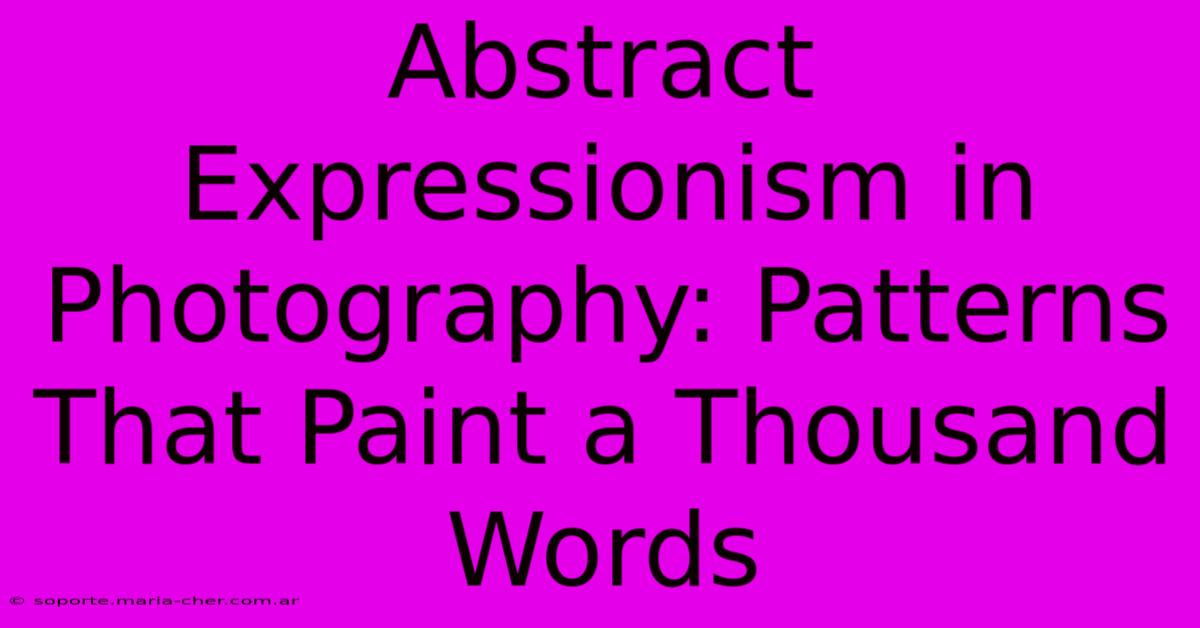Abstract Expressionism In Photography: Patterns That Paint A Thousand Words

Table of Contents
Abstract Expressionism in Photography: Patterns That Paint a Thousand Words
Abstract Expressionism, a post-World War II movement in painting, famously prioritized emotional expression over representational accuracy. Bold colors, gestural brushstrokes, and a focus on the process of creation defined its iconic canvases. But what happens when we transpose these principles onto the medium of photography? This article explores how photographers are harnessing the power of abstraction to create evocative and deeply personal images, using patterns to tell stories without relying on literal representation.
Beyond the Literal: Embracing Abstract Photographic Expression
Traditional photography often strives for sharp focus and realistic depictions. Abstract Expressionism in photography, however, throws this convention aside. It's about finding the expressive potential in texture, light, shadow, and form, creating images that resonate on an emotional level rather than a descriptive one. Think less about capturing a specific moment and more about capturing a feeling, a mood, a visceral response.
Key Characteristics of Abstract Expressionism in Photography:
- Emphasis on Process: The journey of creating the image is as crucial as the final result. Experimentation with techniques, chance encounters, and embracing imperfections all contribute to the unique character of the photograph.
- Emotional Impact: The photographs evoke feelings rather than depict specific subjects. The viewer is invited to engage with the image on a personal and emotional level, interpreting its meaning based on their own experiences.
- Gestural Quality: The photographer's actions – the way they compose the shot, manipulate the light, or even the accidental marks on the negative – become integral parts of the final work, lending a sense of spontaneity and energy.
- Pattern and Repetition: Abstract Expressionist photographers frequently utilize repeating elements, creating visual rhythms and textures that draw the eye and enhance the overall composition. These patterns serve as a powerful visual language, conveying meaning through repetition and variation.
- Color and Light as Emotional Tools: The careful use of color and light plays a pivotal role in shaping the mood and emotional resonance of the image. Bold contrasts or subtle gradations can profoundly impact the viewer's experience.
Patterns as Narrative Devices
In abstract photography, patterns aren't just decorative elements; they become powerful narrative tools. They can symbolize repetition, cyclical processes, order, chaos, or the infinite. Consider:
- Repeating Shapes: A series of identical shapes, subtly varied in size or placement, can create a sense of rhythm and movement. This repetition can evoke feelings of calmness or, conversely, unease or confinement, depending on the context.
- Textural Patterns: The rough texture of a weathered wall, the smooth ripples of water, or the intricate detail of a natural formation—these all contribute to the overall abstract narrative. They add depth, interest and communicate specific feelings associated with the textures themselves.
- Light and Shadow Patterns: The interplay of light and shadow can create stunning abstract compositions. The interplay between darkness and light can represent conflict, serenity, or mystery.
Influential Photographers and Their Abstract Expressions
While not explicitly labeled "Abstract Expressionists," many contemporary photographers employ techniques aligned with the movement's core principles. Seeking out the works of photographers who utilize strong composition, unexpected textures, and powerful use of light and shadow will provide insight into this captivating style. Analyze their techniques and discover how they construct meaning through abstraction and pattern.
Conclusion: The Enduring Legacy of Abstraction
Abstract Expressionism in photography continues to challenge and inspire. By embracing the power of abstraction, photographers unlock a unique potential for self-expression and emotional communication. Through the skillful manipulation of patterns, light, shadow, texture, and form, they create images that transcend the limitations of literal representation and engage the viewer on a deeply personal and profound level. The result? Photographs that paint a thousand words, not through description, but through feeling.

Thank you for visiting our website wich cover about Abstract Expressionism In Photography: Patterns That Paint A Thousand Words. We hope the information provided has been useful to you. Feel free to contact us if you have any questions or need further assistance. See you next time and dont miss to bookmark.
Featured Posts
-
Roses As Affordable As Ecuadorian Chocolates Discover The Hidden Gem
Feb 08, 2025
-
The Ultimate Trophy Andrew Tates Logo A Mark Of True Achievers
Feb 08, 2025
-
Web P To Jpg The Supernova Solution For Image Clarity
Feb 08, 2025
-
A Solucao Facil Cortar Imagens Online Em Um Piscar De Olhos
Feb 08, 2025
-
Wedding Wonder The Ultimate Guide To Million Star Babys Breath Bridal Bouquets
Feb 08, 2025
